Have you just started to learn ukulele, watched some Youtube videos of other players and wondered how they use fingerpicking techniques to take their ukulele playing skills to the next level?
Well, fingerpicking is one of the most important ingredients of ukulele playing. mastering this opens up a whole new world of musical possibilities to you.
You should learn it because, with just your fingers, you can create complex and beautiful music and rhythm that will impress anyone who listens.
But how!! Is it easy??
Don’t worry, This ultimate guide will take you through the basics of ukulele fingerpicking techniques.
After learning this guide, and implementing the tips shared here, you’ll surely be able to master fingerpicking techniques for ukulele.
So, grab your ukulele, and let’s dive into this guide!
Disclosure: This post may contain affiliate links, which means we may receive a commission if you click a link and purchase something that we recommended. Read more about Affiliate disclosure here.
Read also,
Contents
- Thumb and Finger Placement For Fingerpicking
- Basic Fingerpicking Patterns
- Fingerpicking Exercises
- Basic Ukulele Fingerpicking Techniques for Beginners
- Advanced Ukulele Fingerpicking Techniques
- How to Apply Fingerpicking to Songs
- Fingerpicking Practicing Tips For Ukulele Beginners
- Common Fingerpicking Mistakes to Avoid on Ukulele
- Bottom Line
Thumb and Finger Placement For Fingerpicking
As described in the name, fingerpicking is a technique in which fingers are involved to strum the strings.
Basically, all your fingers including your thumb are involved in fingerpicking. But, mostly the thumb, index, and middle fingers are used.
The placement of your fingers and thumb is crucial to achieve the desired sound and avoid unwanted noise.
So, have shared here some tips on the perfect position of thumb and fingers for fingerpicking.
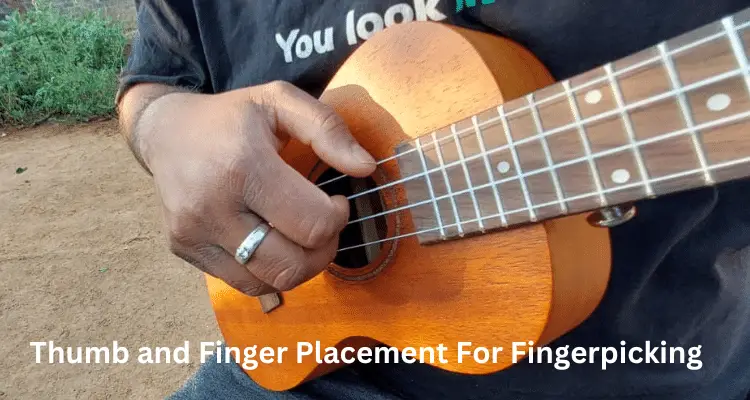
Thumb Placement
- Your thumb should be positioned almost perpendicular to the strings as I do in the image below. The tip of your thumb should be resting on the strings that you’re plucking, or on the upper string (G string).
- You can adjust the angle of your thumb slightly (according to your convenience) to change the tone and volume string.
- You should try to keep your thumb relaxed. Don’t apply excessive force when plucking the strings.
Other Fingers Placement
- Rest the tip of the index finger on the string you’re plucking or on the 2nd upper string (C string). Keep it perpendicular to the direction of the string.
- Your middle finger’s tip should be placed on the 3rd string (E string) or the string you are plucking, and keep it slightly angled towards your thumb.
- Ring finger’s tip should be placed on the bottom string (A string) or on the string you’re plucking. You must keep it slightly angled towards your middle finger.
- Pinky should be placed slightly angled towards your ring finger.
Note: Always keep your fingers and thumb relaxed, only apply just enough force to pluck the strings.
With practice and time, you’ll develop a natural and comfortable fingerpicking technique that works best for you.
Basic Fingerpicking Patterns
As a beginner, you should first start with some basic and easy fingerpicking patterns and then shift to more advanced ones.
With some practice and patience, you can quickly develop your mind to play these basic fingerpicking patterns that will later be used to form more complex techniques down the line.
Now let me share with you these 5 basic ukulele fingerpicking patterns.
1. Thumb and Index Finger Pattern

In this fingerpicking pattern, you have to pluck the G string with your thumb, then the C string with your index finger.
You should repeat this pattern in this number – thumb, index, thumb, index.
2. Thumb, Index, Middle Finger Pattern
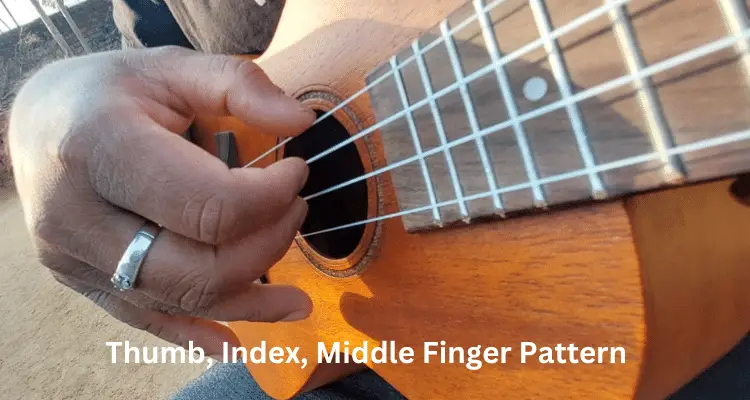
In this pattern you have to pluck G string with your thumb, then C string with your index finger, and then E string with your middle finger.
Repeat in this number – thumb, index, middle, index, thumb, index, middle etc.
3. Alternating Thumb Pattern
This is a great fingerpicking pattern to develop your mind for fingerpicking. In this you have to pluck the G string with your thumb, then the C string with your index finger.
In the second half of the pattern, you have to pluck A string with your thumb, then E string with your index finger.
Repeat in this number – thumb, index, thumb, index, etc.
4. Triplet Pattern
Triplet pattern is another very popular one.
In this you have to pluck the G string with your thumb, then C string with your index finger, and E string with your middle finger.
You have to pluck them all one by one. Repeat in this numbering – thumb, index, middle, thumb, index, middle, etc.
5. Arpeggio Pattern
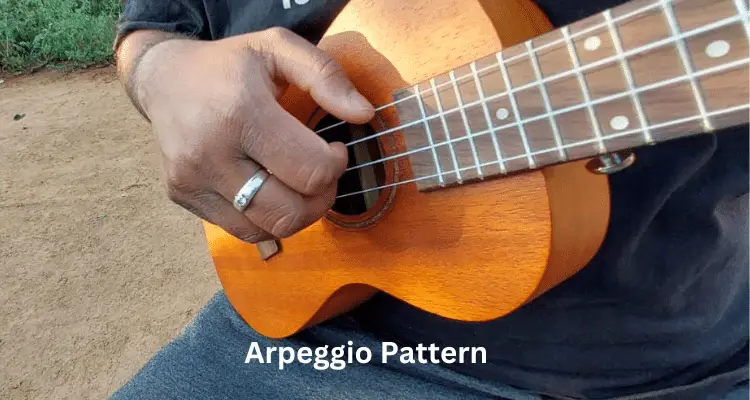
Arpeggio pattern needs you to pluck the G string with your thumb, then C string with your index finger, E string with your middle finger, and A string with your ring finger.
In this pattern, all the strings are used. Repeat this pattern – thumb, index, middle, ring, middle, index, etc.
Tip: Here I have two tips for you. First, always use a metronome to be perfect in timing. and the second one, Start slowly and gradually increase your speed. By following these two tips you will see how fast you’ll master these basic patterns.
You can also combine them and add your own variations and create your own unique fingerpicking style.
Read also,
Fingerpicking Exercises
Exercise is one of the important ingredients of learning ukulele. If you exercise the right things regularly then you will master the ukulele quickly.
In this section, I will share with you some fingerpicking exercises helpful to master this quickly.
1st Exercise: Basic Fingerpicking Pattern Practice
You can choose one of the basic fingerpicking patterns that we have discussed above and play the pattern slowly.
Make sure you’re plucking each string accurately without bogged down with other strings.
When you repeat the pattern over and over, you will see that you can play the pattern smoothly and evenly.
2nd Exercise: Spider Walk Exercise
In this exercise, you have to hold your finger like this
- Index finger on the G string
- Middle finger on the C string
- Ring finger on the E string
- And pinky finger on the A string.
Now pluck each one in sequence from top to bottom; G, C, E, A. After one set of strokes move your hand 1 fret up and repeat the same exercise.
Continue this exercise until you reach the 12th fret. Once you reach the 12th fret, reverse the sequence on fretboard.
3rd Exercise: String Skipping Exercise
To start with this exercise you need a simple melody or chord progression. If you don’t know much about chords then you should read my guide on The 4 Basic Ukulele Chords.
The basis of this exercise is skipping strings between each note or chord.
Let me show you an example.
- Suppose you’re playing a C chord.
- Then according to the exercise you have to pluck the G string with your thumb.
- Now skip to the A string and pluck this string with your index finger.
- Then skip to the E string and pluck that string with your middle finger.
- And so on…
4th Exercise: Chord Melody Exercise
Like the above exercise, this one needs a simple melody or chord progression.
In this, you have to use the thumb to play the root note of each chord and use the other fingers to play the rest of the melody.
For example, suppose you are playing a C chord.
Then play the C note on the A string with your thumb and then use your other fingers to play the rest of the melody part on the C, E, and G strings.
Basic Ukulele Fingerpicking Techniques for Beginners
Now that you know some basic fingerpicking patterns and exercises, it’s time to unlock basic ukulele fingerpicking techniques perfect for beginners like you.
Thumb and Index Finger Technique
This technique is very similar to thumb and index fingerpicking patterns. It needs you to pluck G string with your thumb and then C string with your index finger.
You can use this technique in a variety of songs. It is the best technique for simple accompaniment to your singing.
Alternating Thumb
Alternating thumb is another popular ukulele fingerpicking technique based on “thumb and index finger pattern”, I have described above.
- In this technique you have to pluck G string with your thumb, then C string with your index finger.
- In the second half of the pattern you have to pluck A string of your ukulele with thumb, then E string with your index finger.
It adds an extra bass note to your plucking and gives the fingerpicking complexity.
Pinch Technique
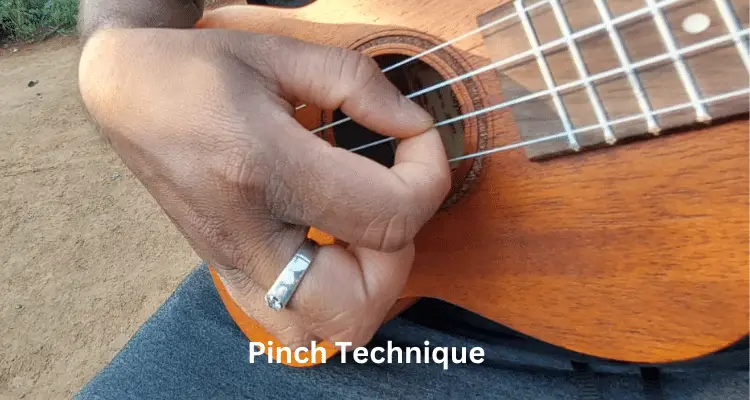
In this technique, you have to pinch the strings. Such as pinch G and E strings with your thumb and index finger simultaneously.
If you want a bright tone in your chord patterns then this technique is great. It emphasizes a chord or melody note by adding contrast to the fingerpicking pattern.
Roll Technique
Roll technique is based on rolling your fingers across the strings.
In this you have to roll your fingers starting from thumb on G string and then index finger on C string, then middle on E string.
If you want an arpeggiated sound then this fingerpicking technique is best. It works well for chord progressions.
Clawhammer Fingerpicking Technique
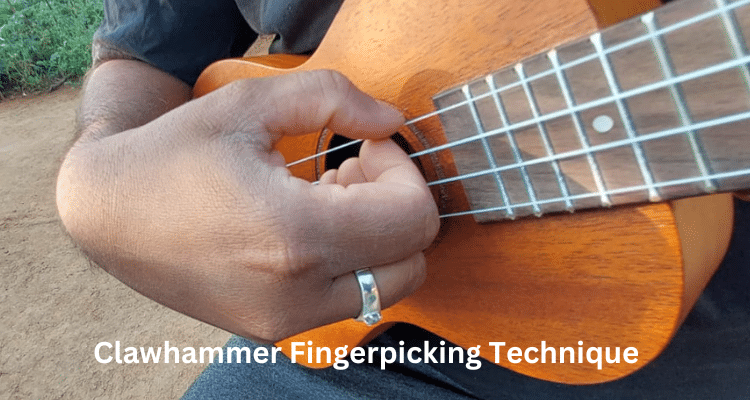
Clawhammer technique is a combination of two techniques. In this, you have to first pluck G string with your thumb and then strike the string with back of your fingernail.
Now brush down through C, E, and A strings with your index, middle, and ring fingers.
This technique is common in folk and bluegrass genres of music.
These are some of the basic fingerpicking techniques you can practice and accompany the vocal.
Advanced Ukulele Fingerpicking Techniques
Now let us see some advanced fingerpicking techniques that need an experienced hand on the ukulele.
Once you have a good hand on the basic fingerpicking techniques, you can try them out.
First off,
Travis Picking
Travis picking is similar to alternating thumb picking. But it’s a more complex pattern. It has additional plucking and muting techniques.
Here are the steps to this fingerpicking technique.
- Pluck G string with your thumb, and then C string with your index finger.
- Mute C by using your palm or thumb, then pluck E string with your middle finger.
- Now mute E string with your palm or thumb, and pluck A with your index finger.
You can use this pattern for a variety of songs in different genres. It adds a complex and rhythmic accompaniment to the songs.
Harmonics
In this fingerpicking technique, you have to lightly touch a particular string with your index finger at the 12th fret (You can also use other harmonic locations) and pluck that string with your thumb or other fingers.
You will listen to a bell-like tone which can be used in between the song as a special effect.
Tremolo
I used this technique in many songs. In this, you’ve to rapidly alternate between two or more notes.
YOu can use your thumb or any other fingers to do this. This technique creates a fast flow in the rhythm and adds excitement to a melody or chord progression.
Campanella
This technique lets you use open strings to play the melody and different fretted notes on the other strings. This will create a bell-like sound.
You need precise finger placement to add this unique and complex sound to the melody.
Percussive Slaps
Pecussive slap is commonly used in guitar rhythmic patterns and Rumba Flamenco is one of its variations on guitar. You can experiment with this on your ukulele.
Use your thumb or fingers to slap the body of your ukulele along by playing a melody or chord.
This technique can be used to add a percussive melody pattern to provide certain beats and notes together.
How to Apply Fingerpicking to Songs

Applying fingerpicking techniques to songs perfectly is a subject of practice.
However, I have shared here some tips on this.
Start with a simple pattern: You should always begin with basic patterns, such as alternating thumb or roll. Use slow songs to practice the patterns. Slow songs will be easy to practice.
Listen to the song: Listen carefully to the song that you want to apply fingerpicking on. Try to identify the rhythm and melody of the song. Identify the spots where chord changes and define them. Try to identify the strumming or picking patterns used in the song.
Choose the right pattern: Choosing right fingerpicking pattern that suits the song is important. It should complement the rhythm and melody of the song.
For example, if the song has a slow melody then roll or Campanella pattern might work well. Travis picking or percussive slap pattern is great for fast rhythmic song.
Practice with a metronome: To master the perfect tempo and timing you should practice with a metronome for at least 25 minutes on a daily basis. You can buy a metronome or download an app to practice with it.
Apply the pattern to the song: Once you are comfortable with a particular fingerpicking pattern, go and search for a suitable song and define the chords. Now start strumming according to that fingerpicking pattern.
Fingerpicking Practicing Tips For Ukulele Beginners
If you are a ukulele beginner then you should practice fingerpicking like this.
- Start with slow speed: Practicing at a slow speed makes you perfect. With slow speed, you can focus on developing a smooth and even rhythm.
- Use a metronome: As I told you above, using a metronome to practice fingerpicking patterns improves your timing skills. This will help you to develop a sense of rhythm and timing.
- Practice regularly: You should practice fingerpicking techniques regularly to build your muscle memory and let your mind adopt them. Set a dedicated routine on a daily basis to practice regularly.
- Focus on accuracy: If you want accuracy and precision then you should focus on your practice. Each note and chord should be played clean and clear.
- Practice with a backing track: If you have backing tracks available then practice with them. This will help you develop your timing.
- Experiment with different patterns and techniques: Experiment with different fingerpicking patterns and techniques. Try to master new patterns with different songs and chord progressions.
- Take breaks: And, always take regular breaks during your practice session otherwise you will invite fatigue and injury. Stretch your fingers and hands before and after playing.
Common Fingerpicking Mistakes to Avoid on Ukulele
Beginners often do mistakes when practice fingerpicking exercises on ukulele. Here’ve shared some of them so that you could relate to and avoid them.
- Not anchoring your hand: It is a very common mistake. In this people do not anchor their hand on the uke. This will result in a lack of control and accuracy in fingerpicking patterns. So, make sure to anchor your hand on the uke’s bridge or body. This will provide you with stability and control.
- Using the wrong fingers: Another common mistake is using wrong fingers during fingerpicking which makes it more difficult. Use the right fingers as I have described above in the patterns.
- Not using alternate picking: Beginners often use the same finger to pluck each string which is wrong. It can make fingerpicking patterns sound choppy and disjointed. So use alternate fingerpicking that I have already shown above.
- Playing too fast: By playing fingerpicking patterns too fast you cannot become master in a week. You should avoide this. Start slow and gradually increase your speed.
- Too much tension in your hands: Don’t apply too much tension on your hands. I t will make fingerpicking more difficult. It also cause pain or injury. Keep your hands relaxed and loose when playing.
- Focusing too much on the picking hand: In the beginning, you focus too much on the picking hand. You should focus on both the hands.
- Not practicing enough: Fingerpicking requires consistent practice and time to improve. So, practice regularly. Don’t take more then 2-3 days otherwise you start losing muscle memory.
Bottom Line
Whether you are a ukulele player or a guitar player, it’s essential to you to learn fingerpicking techniques.
By practicing the above basic fingerpicking patterns and techniques, you can improve your playing skills with time.
Start slow, use proper finger placement and technique, and practice regularly, if you want to master this.
While practicing enjoy it, have fun and experiment with different fingerpicking patterns and techniques.
Soon, you will see how familer you would be with ukulele fingerpicking.
Let me know in the comments, if this is helpful to you.
Read also,
